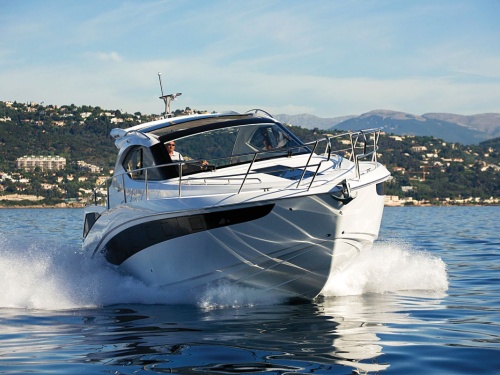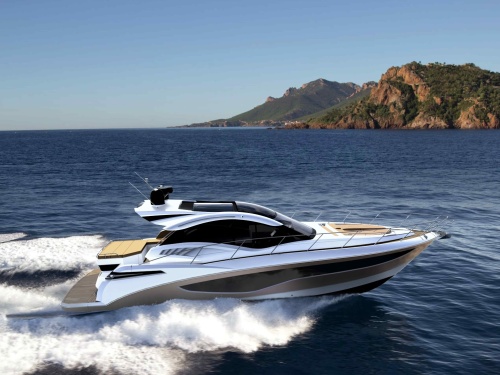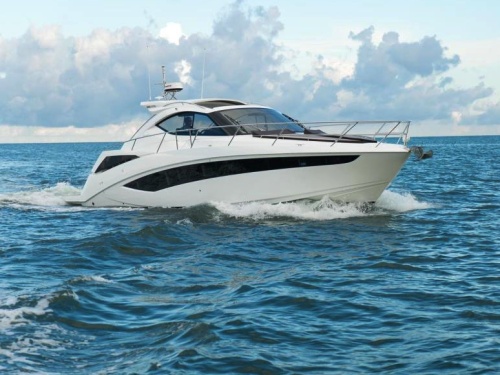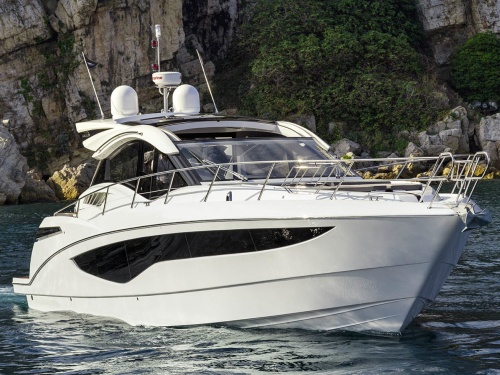Access More Boat Tests
Already have an account? Login
Galeon 450 HTC (2023-)
2 x 480-hp Volvo Penta D6
Brief Summary
The Galeon 450 HTC includes all the essentials for day and night entertaining, day boating and longer cruising. Equipped with Galeon’s famous Beach Mode, port and starboard gunwale/decks, an optional hydraulic swim platform and its two-cabin, two-head design with a full-beam master, this versatile vessel has been designed for owners who want big motoryacht functionality in a compact package.
Test Results
| RPM | MPH | Knots | GPH | MPG | NMPG | STAT. MILE | NM | dBa |
|---|---|---|---|---|---|---|---|---|
| 1000 | 6.6 | 5.7 | 1.9 | 3.6 | 3.1 | 1445 | 1256.4 | 62 |
| 1250 | 7.9 | 6.9 | 3.4 | 2.3 | 2 | 941 | 818.3 | 63 |
| 1500 | 9 | 7.8 | 5.6 | 1.6 | 1.4 | 653 | 567.9 | 64 |
| 1750 | 9.1 | 7.9 | 8.5 | 1.1 | 0.9 | 431 | 375 | 65 |
| 2000 | 9.6 | 8.3 | 13.5 | 0.7 | 0.6 | 288 | 250.4 | 70 |
| 2250 | 11.1 | 9.6 | 19 | 0.6 | 0.5 | 236 | 204.8 | 74 |
| 2500 | 17.6 | 15.3 | 21.5 | 0.8 | 0.7 | 331 | 287.5 | 72 |
| 2750 | 21.1 | 18.3 | 25.5 | 0.8 | 0.7 | 334 | 290.7 | 73 |
| 3000 | 24.5 | 21.3 | 31.5 | 0.8 | 0.7 | 314 | 273.4 | 73 |
| 3250 | 27.3 | 23.7 | 38.5 | 0.7 | 0.6 | 287 | 249.7 | 75 |
| 3500 | 29.5 | 25.6 | 45 | 0.7 | 0.6 | 265 | 230.5 | 76 |
| 3730 | 31.3 | 27.2 | 53.5 | 0.6 | 0.5 | 237 | 206 | 78 |
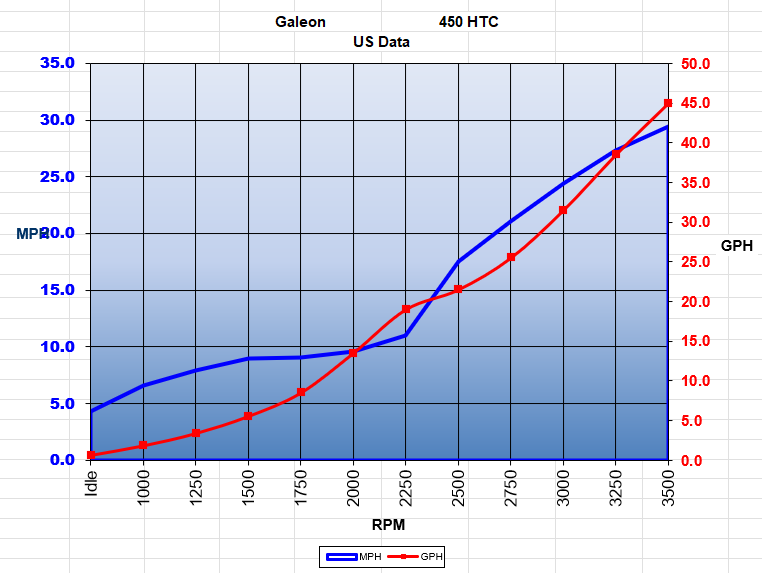
Specifications
| Length Overall |
45' 9" 14 m |
|---|---|
| Beam |
20' 8" 6.35 m |
| Dry Weight |
34,615 lbs. 15,701 kg |
| Draft |
4' 3" 1.3 m |
| Bridge Clearance |
14' 4" 4.38 m |
| Fuel Capacity |
450 gal 1,700 L |
| Water Capacity |
112 gal 425 L |
Acceleration Times & Conditions
| Time to Plane | 6.4 seconds |
|---|---|
| 0 to 30 | 20.3 seconds |
| Climate | 90 deg., 87 humid; wind: 2-7 mph, seas: calm |
Engine Options
| Tested Engine |
2 x 480-hp Volvo Penta D6 |
|---|---|
| Std. Power |
2 x 480-hp Volvo Penta D6 |
Captain's Report
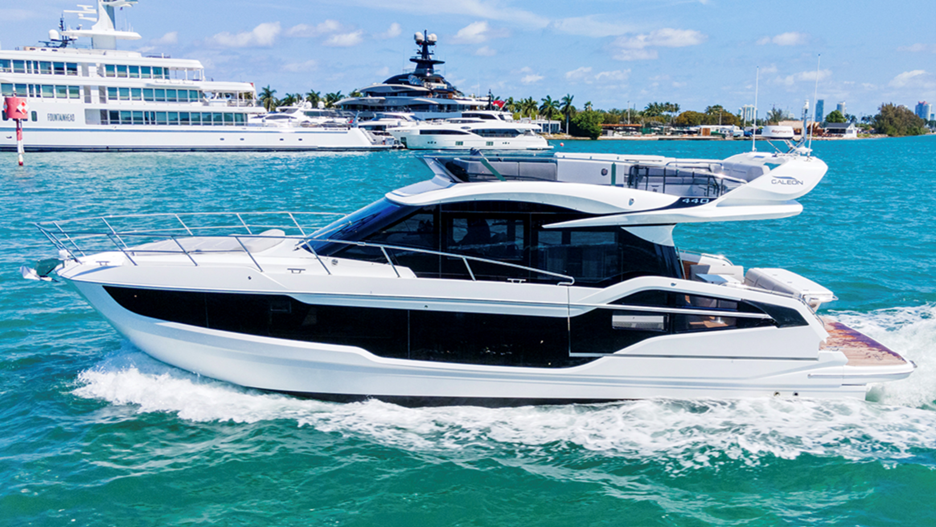
Brief Description
The Galeon 440 Fly and 450 HTC are essentially the same boat with the 440 Fly having the same hull and interior accommodations as the 450 HTC (Hardtop), but with the addition of a sport flying bridge. Innovation and quality meet aboard the Galeon 440 Fly to create a mid-size cruising boat designed for people moving up from smaller vessels. She offers exterior and interior space resulting in a comfortable, practical, and versatile boat transitioning from the outdoor spaces of a dayboat to the inside accommodations of a cruiser.
Major Features
- Gunwales in the sterns that fold down to extend the deck
- Electric anchor winch
- Hullside windows w/integrated opening portholes
- 316 stainless rails throughout
- LED lighting
- Aft shower
- Extended swim platform w/teak decking
- 67,000 BTU air conditioning system
- 12-kW Fischer Panda genset w/ sound shield
Mission
The mission of the 440 Fly and 450 HTC is to attract boaters moving up from smaller boats to ones that have three staterooms for a growing family while providing the outdoor venues popular in day boats. As such, these two models serve as an easy transition from one category of yacht to a larger, more complex boat, but one that is easy for an owner/operator to manage. She is also designed for economical operation and family comfort.
Performance
The engines. Both models are powered with twin Volvo Penta D6 480-hp diesels with V-drives. The D6 diesel was designed years ago expressly for the marine market and is not a warmed-over truck engines. This is one of the reasons that is so suitable for yachts and over the years it has proven itself to be reliable and relatively trouble-free. Volvo Penta has a large parts warehouse in the U.S. and delivery of replacement parts is generally prompt according to our sources.
We only tested one of the models – the 450 HTC (Hardtop) which had an estimated test weight of 41,240 lbs. (18,701 kg), 1,982 lbs. (900 kgs.) less the flying bridge model. The boat’s beam is 13’8” (12.59 m).
Wide open throttle (WOT) speed of the 450 HTC was 31.3 mph (27.2 knots) at 3730 RPM. As in all boats, vessels are rarely operated at top speed for more than a few minutes, so this number is not particularly meaningful
Best cruise, which is to say the most economical speed at which to maximize planning or semi planning travel was found at 2750 RPM where she achieved 21 mph (18.3 knots) burning 25.4 gph getting .7 nautical miles for a range of 290 nautical miles. This range is typical for a boat of this size.
We found the performance to match the mission of the boat, which is to be an economical family cruiser, with the emphasis on riding comfort and economy. Riding comfort means keeping speeds down to match the conditions, and economical operation inherently means operating at moderate speeds.
Handling
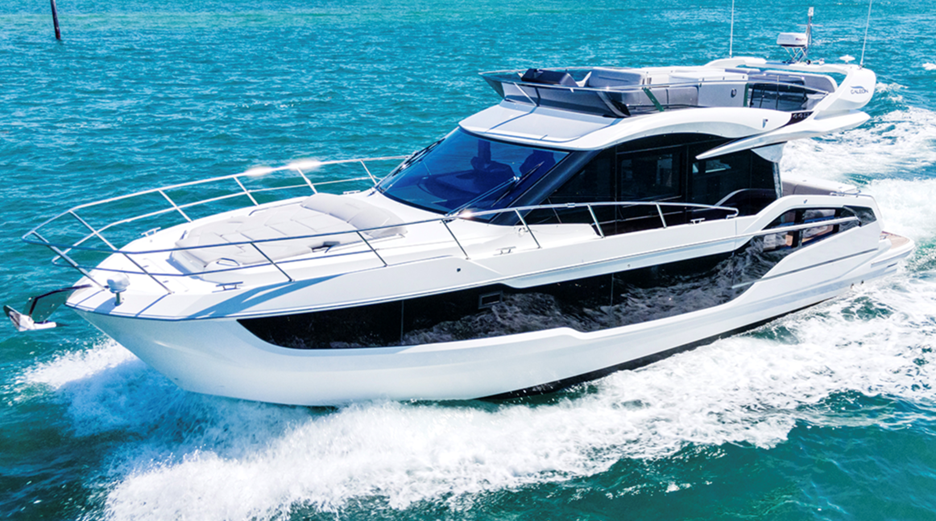
Galeon and its U.S. importer MarineMax have set up our test boat for easy operation for people moving up from smaller boats. To that end it had equipped the 450 HTC with Side-Power electric bow and stern thrusters. These thrusters make docking easy and controllable for even a new-comer, because alignment with slips, and over-coming beam current is intuitive.
Offshore, steering was easy with the boat’s hydraulic steering, with reasonable feed-back to the wheel. Because the boat is straight-shaft with a rudder, and not pod driven, its turning radius is tight. With the interceptors off, she leas about 10-degres into a turn, which is comfortable. With the interceptors on, the lean was less, depending on speed.
ZipWake interceptors. Our test boat was also equipped with automatic ZipWake interceptors instead of traditional flap-type trim tabs. This a dynamic trim and roll control system that mitigates roll and pitching to some degree by using its internal GPS and gyro sensors to automatically level the boat in terns, rough water, or uneven weight distribution. Because the interceptors do their work by only extending a relatively small distance below the hull of the boat, they present far less drag than trim tabs which is ten much deeper.
Flying Bridge
The flying bridge has been engineered to maximize guest seating for entertaining and sightseeing. In fact, we’d be hard-pressed to get any more seating there. The air draft of this vessel is 19.39' (5.91 m), including the mast. The 450 HTC has an air draft of 15.55' (4.73 m) and 12.33' (3.75 m) with the mast down.
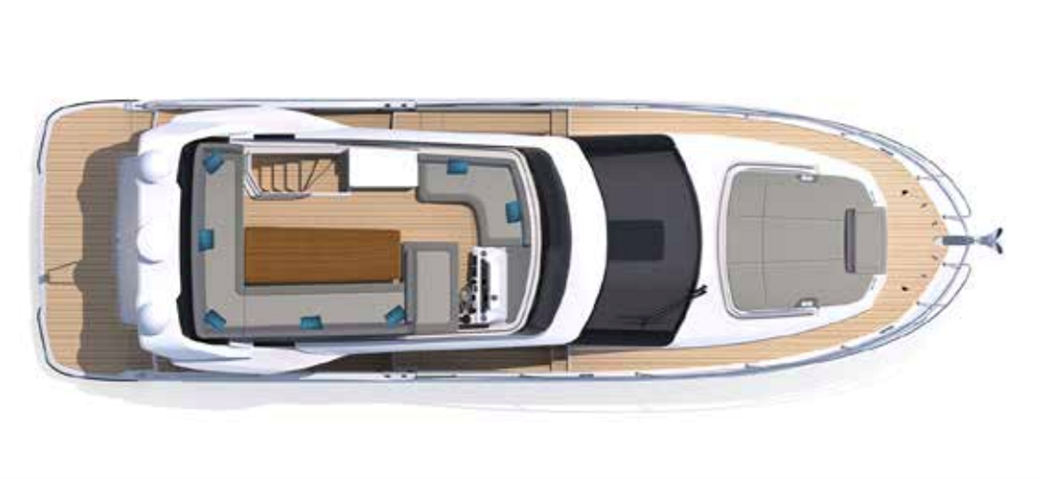
The sizable fly bridge deck features a sofa to starboard sweeping around the aft section, as well as the double-wide helm bench seat, along with an additional couch opposite the helm to port, and an optional wetbar/electric grill. The helm is to starboard and offers unobstructed, 360º views for the driver. While the sights are great, and there is that exhilarating feeling of running the boat from up there, this is still an open bridge configuration and subject to wind and sun. An optional, and foldable, bimini top can offer some relief from the elements. We recommend the bimini option.
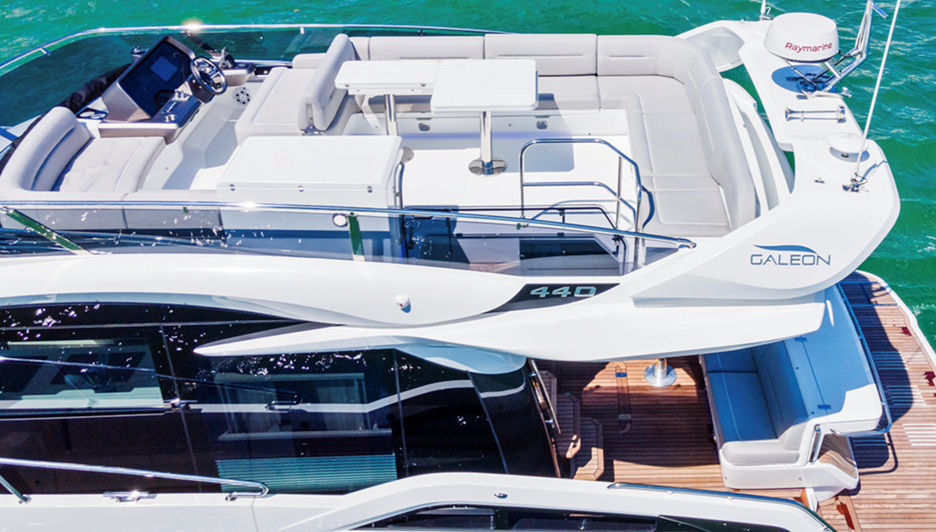
The helm features compass, outlets and USB, a 7” Volvo Electric Vessel Control (EVC) panel, fire system monitor, engine ignition panel, trim tab control panel, dual level control, and Galeon steering wheel. Optional Raymarine electronics include Axiom 12+ chartplotter, 18-inch Quantum Q24C digital radar, with an additional Raymarine chartplotter located on the main deck helm station. The VHF Ray 91 AIS and antenna, and Raymarine EV-1 autopilot are also optional.
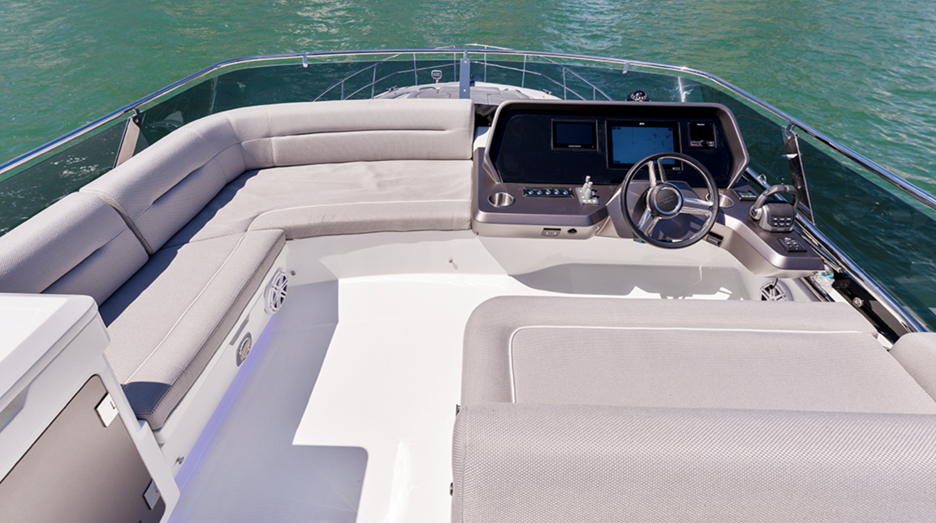
This area is sure to be the center of attraction while underway, at a favorite anchorage, or a great place to relax after a day’s travel and before dinner on the main deck. Secure transit is via a wide stairway to port.
Main Deck
Boarding is thanks to the big platform aft where a single step up puts you on the aft deck with dining table and seating. There is an optional grill which can be set into the transom. This feature effectively creates more living space as now the swim platform becomes a venue for outdoor cooking.
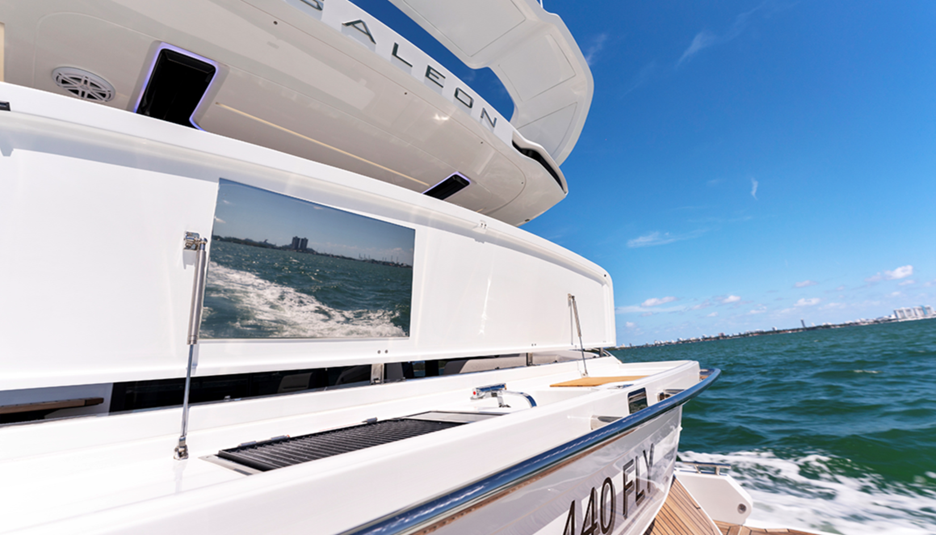
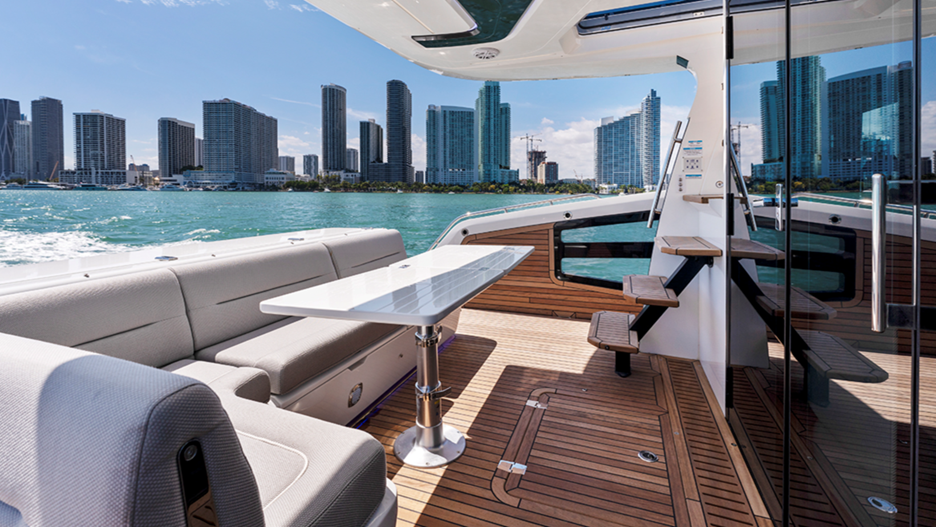
Aft Deck
The transom bench seat with fold-out table and be used for cocktail parties and al fresco dining, and with the addition of two stools forward can seat six. The table is high-low and is dropped down to make a sun pad.
Aft Quarter Platforms. Galeon is the builder that popularized the fold-down gunwale platforms which has led the industry into this feature. The Galeon 440 Fly’s standard expanding side decks offer more 3’6” (1.6 m) on each side more entertaining space, as well as a fun place for guests to dive into the water. A clever glass window is embedded in the gunwale/platform so the water below can be seen. This is a feature that has little practicality, but it adds to the visual excitement of being on the platform. The platforms are easily deployed.
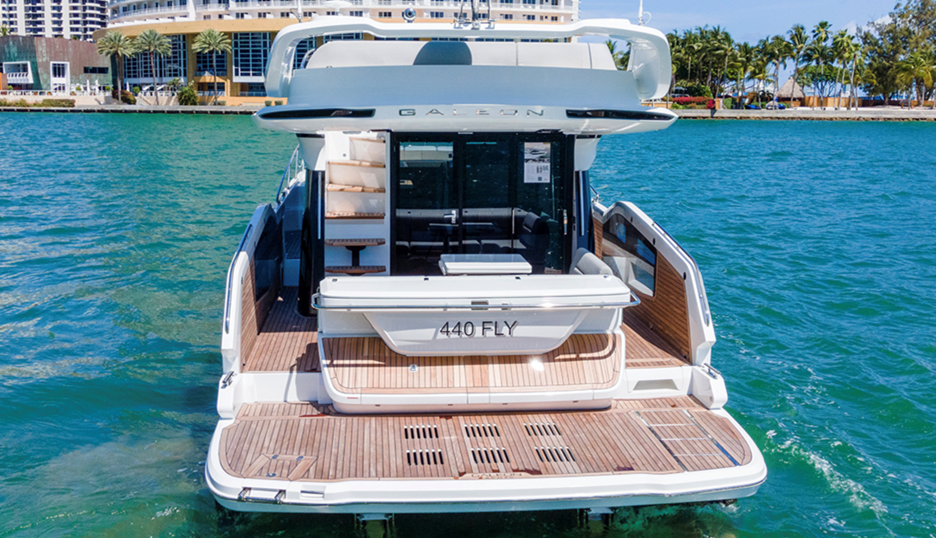
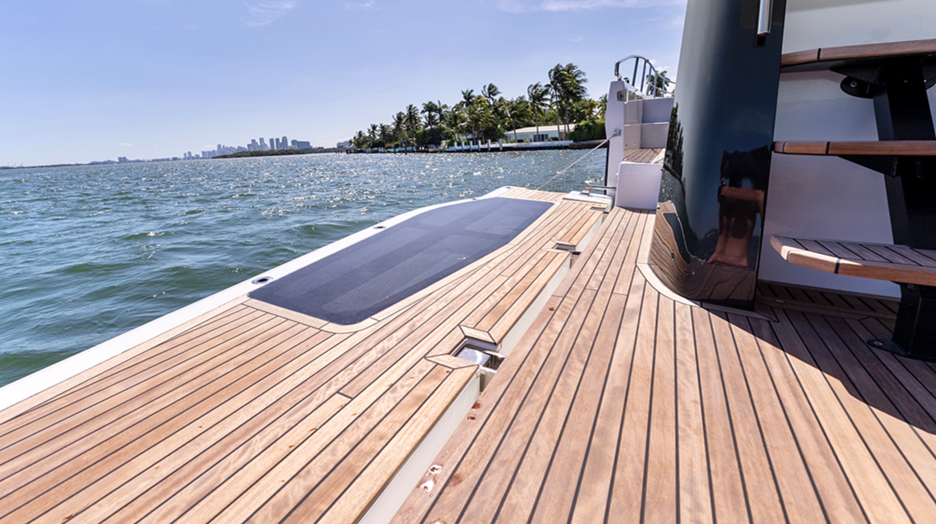
Bow Area
The bow area is accessed by narrow side decks with high side rails for safety. Once there, the top of the trunk cabin is covered with a large sun bed in three longitudinal sections. The backrests rise, turning the sun pad into as many as three chase lounges. Cup holders and hand-holds are port and starboard.
Forward on the pad is a section of the pad that lifts up to make a welcome forward observation seat. The pad section over the forward hatch can be removed to let light or air enter below.
The ground tackle is concealed below fiberglass hatches forward, along with the vertical electric windlass. There is adequate access to the chain locker. A galvanized anchor, 44 lb (20 kg) with 197 ft (60 m) of 5/16” (8mm) galvanized chain with leash protection, is standard. We would add another 50’ of chain and consider springing for the extra cost of a polished SS anchor – not because it holds better, but because it makes the boat look so much better.
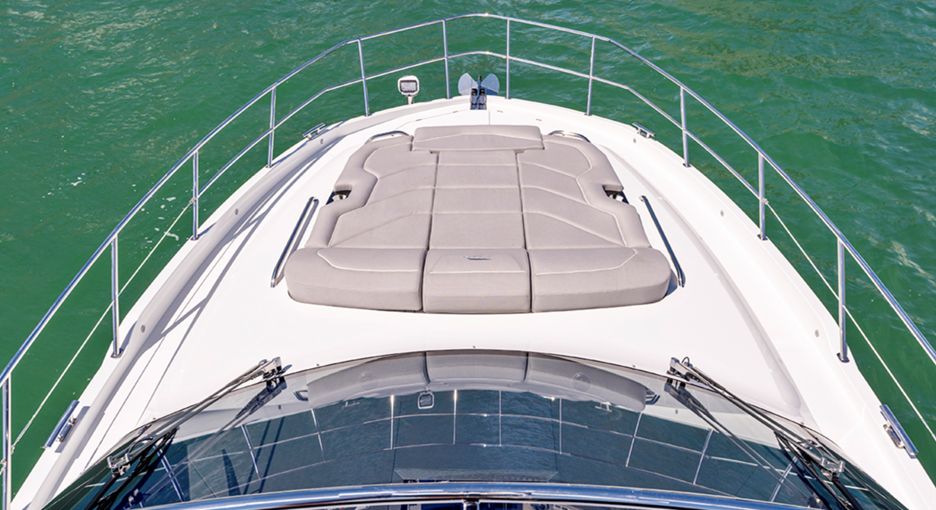
Salon
The salon, galley and lower helm all share the main deck inside the cabin. The space is divided into two sections, with the aft area the salon/dinette and the forward section the galley and helm. Two, very low-rise steps from the salon up to the galley, further separate the two venues. While this is a traditional layout, Galeon has done a fine job of making this cabin both functional and aesthetically pleasing.
Storage space is at a premium because the space below the bench seats is used to accommodate the overhead in the master cabin below. The master stateroom, however, does have large storage cabinets and drawers.
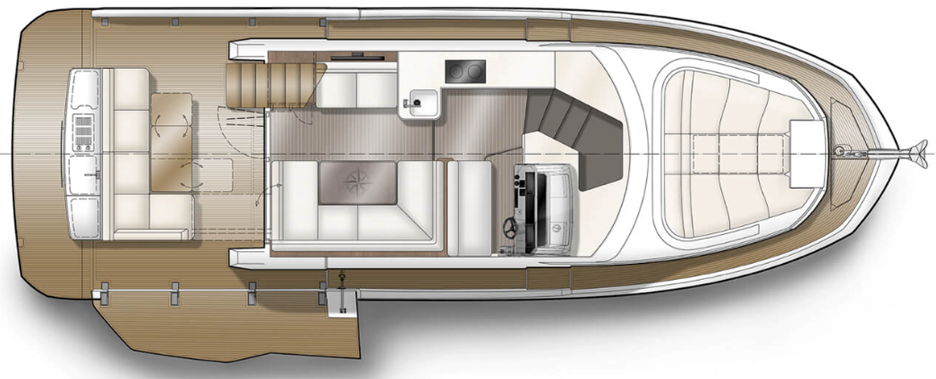
The use of fold-up table-tops and pullout stools add functionality in a small space. Overhead cabinets in both the salon and the galley provide a modicum of much-needed storage. Drawers under the galley counter and helm seat are welcome. The flying condiment platform over the galley adds visual appeal and practicality.
The cabinets and bulkheads are covered in an unusual gray-stained Eucalyptus veneer with vertical grain. We particularly appreciate the horizontal textured fabric treatment on the window mullions and structural supports. On the overhead there are three rectangular soffits with indirect mood lighting, much as you might find on a large motoryacht. These simple details, to our mind, help position the boat as something special, even though her hull length is only 41’3” (12.5 m).
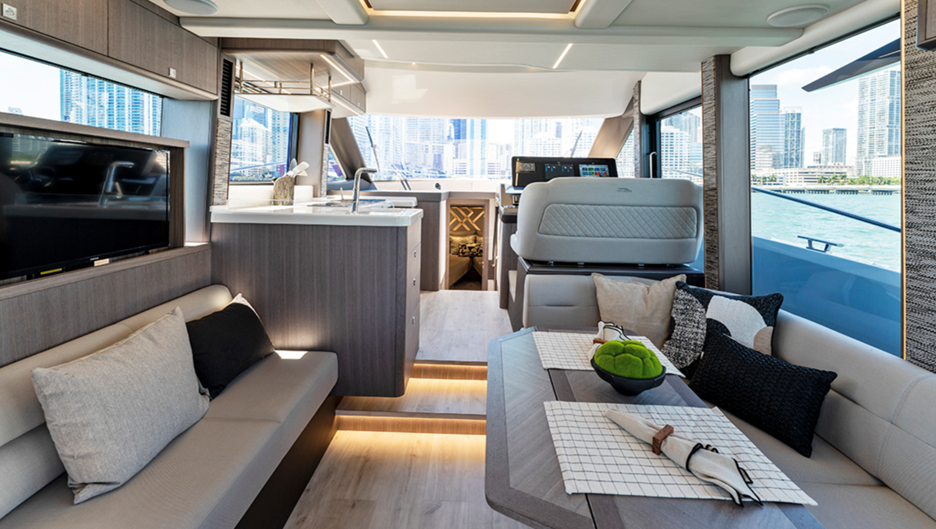
The Helm
The lower helm, with a double bench seat, is to starboard and is a fixed seat. Outboard is a sliding glass door that gives access to the narrow side deck to aid single-handed line handling. The forward windshield is a wide, single piece of glass, and a pair of large, pantograph sweeping windshield wipers will keep things clear during inclement weather. Thankfully, they are synchronized and have a spritz system to clean off salt. There are also welcome defroster outlets.
The forward diagonal of the A-frame support is substantial in order to handle the flying bridge loads, and the operator must be cognizant of this blind spot to the give-way vessel.
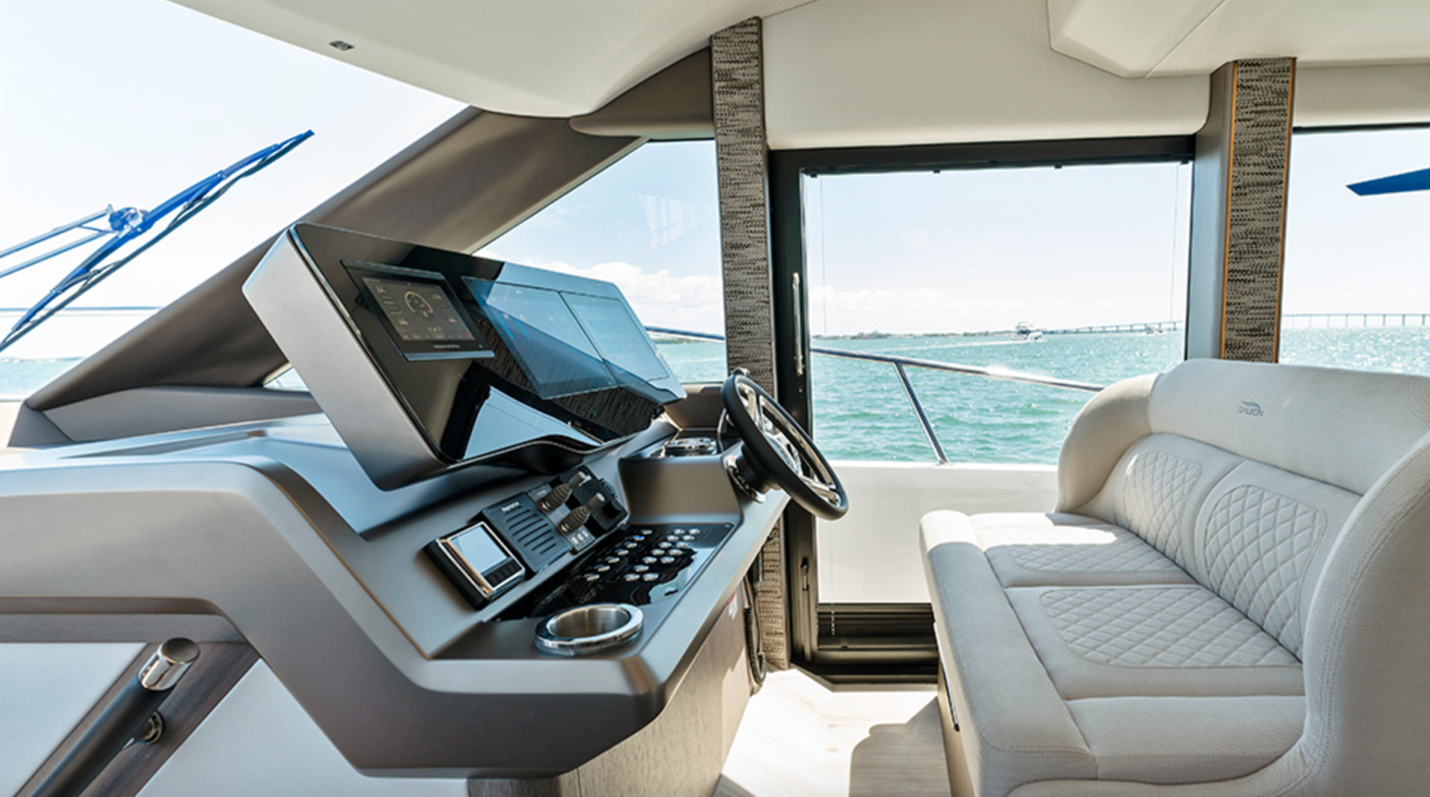
The dash has a raised instrument console which is an attractive design element instead of having the MFDs in a raised on-piece dash, like most other boats. The helm console has all of the expected controls and buttons for electrical accessories. The cup holder will be used for a smartphone, so we’d like to see adjacent connectivity. There are welcome A/C vents at the helm.
The Galley
The fully found galley is directly opposite the helm and is complete with a 240V, two-burner induction cooktop, Corian countertops, stainless steel sink with chrome faucet and Corian cover, overhead LED lighting, 120V microwave, and 12V refrigerator with freezer compartment, a trash receptacle, and enough storage, cabinets and overhead cupboards for light traveling.
One feature that all chefs will like is the electric window right over the work area. This is an unusual feature and brings fresh air into the cabin right where it’s needed.
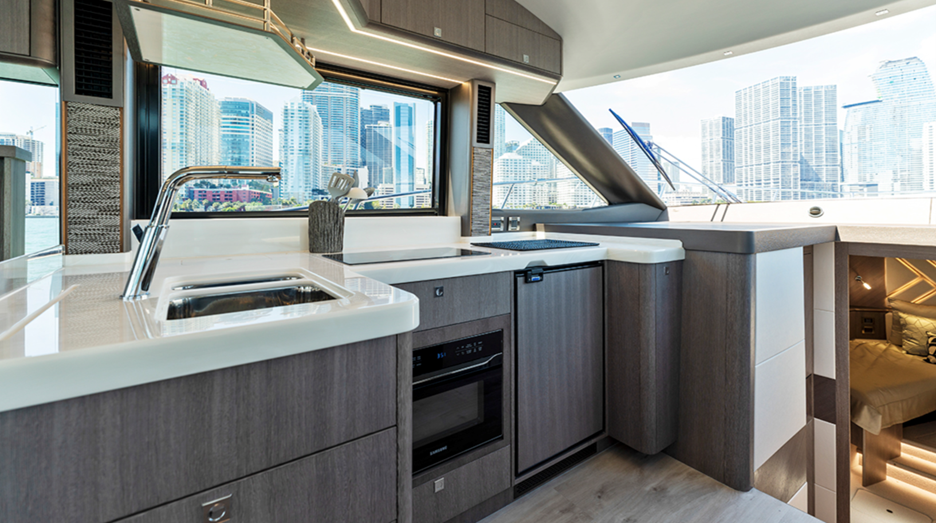
Accommodations
The Galeon is available in three different layouts. The standard layout offers three cabins and two heads, with the full-beam amidship master, with private door to head and separate shower, forward VIP with one large berth (perhaps bunks could be made available if wanted), guest quarters have bunks. The VIP and guest quarters will share the head and shower, which also serves as the day head.

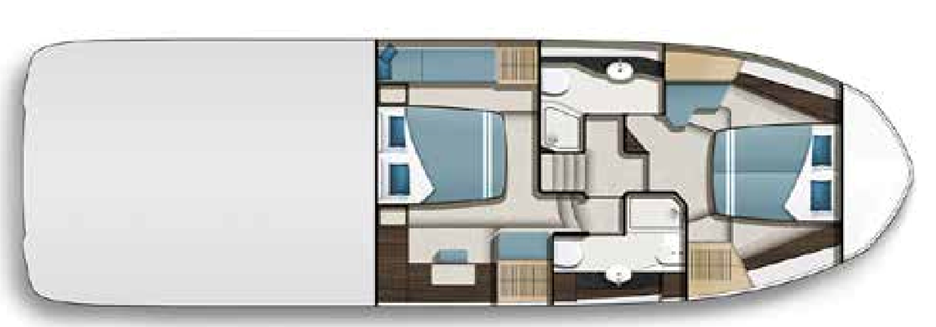
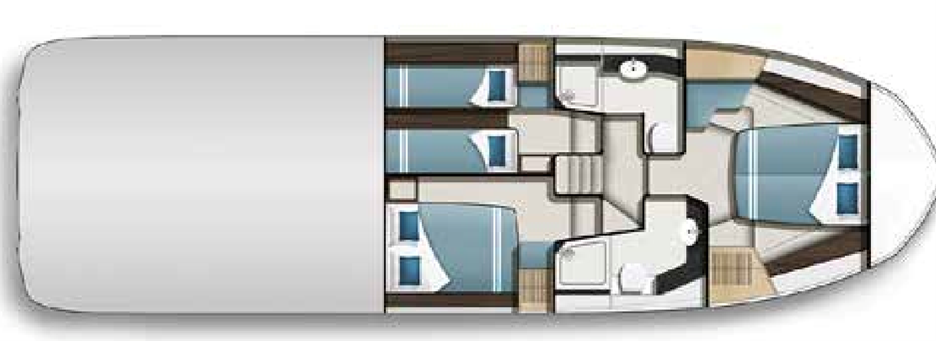
The boat we tested was the only two-stateroom version and we suspect that MarineMax ordered this version for good reason. What can’t be seen in these layout drawings is the configuration of the overhead in the master stateroom. Because of the relatively low profile of this boat, the headroom in the master must conform to the configuration of the built-in seating and deck above.
This is not an unusual design element of modern sports yachts as large as 65’ (19.8 m). Indeed, almost every new boat in the sport yacht category has multiple headroom clearances in the master, and sometimes the guest cabin. Typically, only the VIP cabin forward has a single high overhead around the foot and the sides of the bed.
Before selecting a layout, buyers must consider how the boat will be used, for how long cruising adventures might be and with how many people. The three-stateroom layouts might be just the ticket for couples with a number of young kids. Older buyers might appreciate the more open spaces and larger heads of the two-stateroom layout.
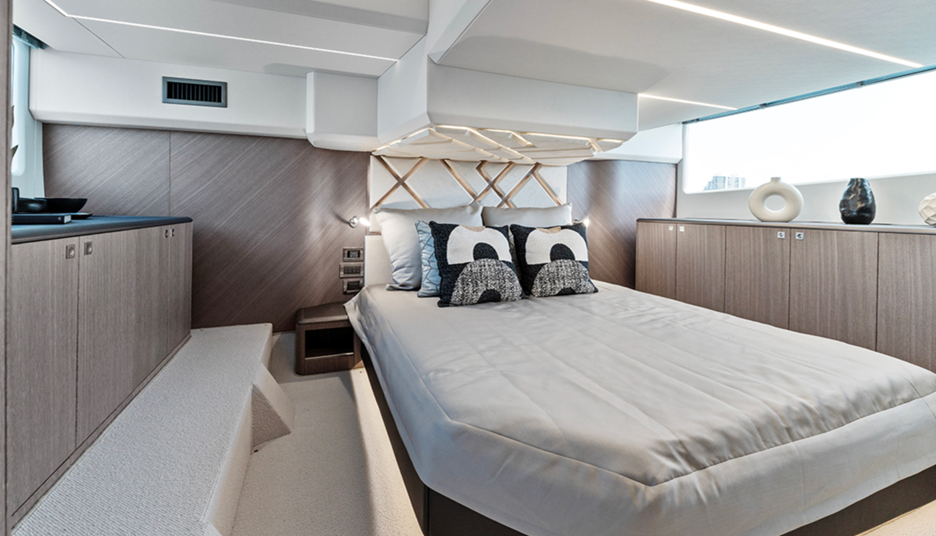
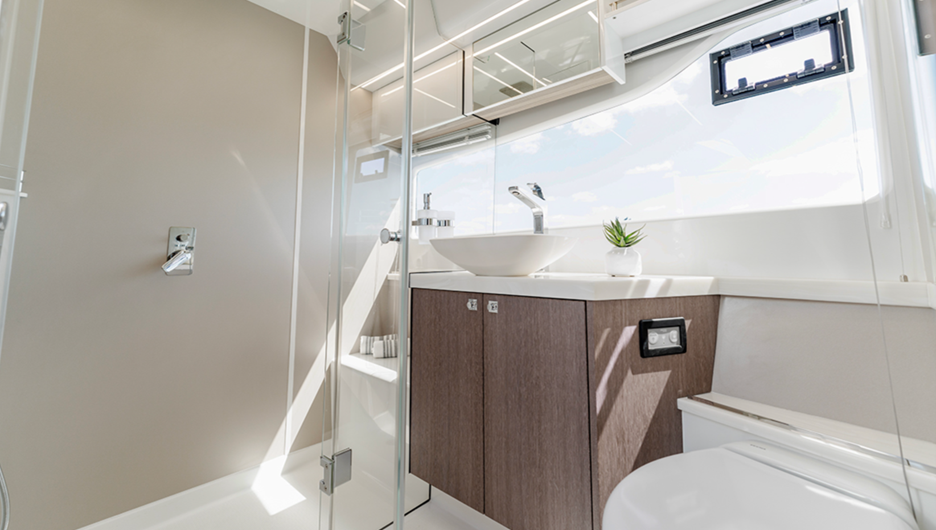
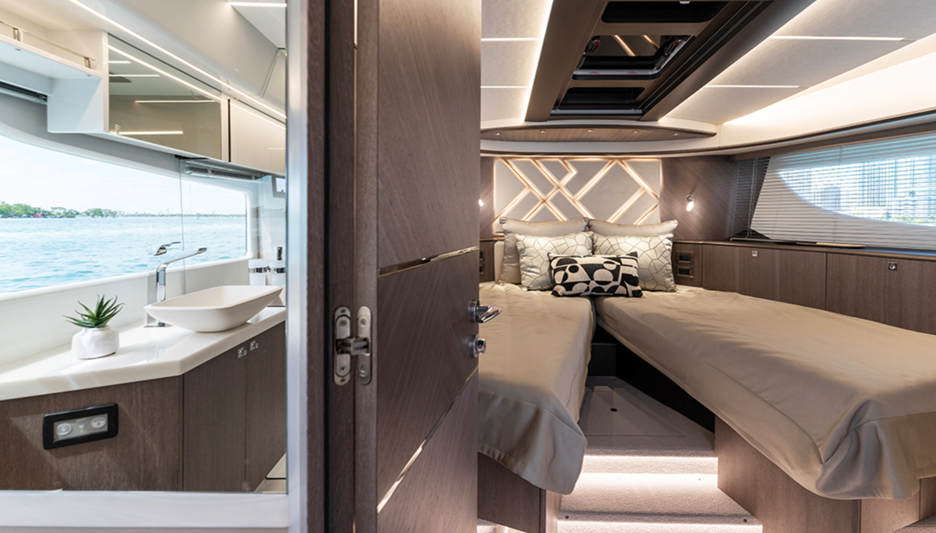
Other layouts include a two-stateroom and three-stateroom conventional arrangement as illustrated by the schematic diagrams on this page.
Engine Room
For the hands-on skipper, the engine room is accessed through a large hatch in the cockpit. The space is brightly lit with LED lights over the twin 480-hp Volvo Penta D6 V-Drive engines. All required engine checks, valves, pumps, filters, panels and systems, including the 12kW Fischer Panda genset, are within reach. The generator has a sound shield.
The fuel tanks are 316 stainless steel, which is an important feature, as many boats in class have aluminum fuel tanks. These tanks cost more, but are less likely to corrode and overall are more robust.
The A/C condensers are also located here and produce 67,000 BTUs of cooling. There is an 11-gallon (40 L) hot water heater.
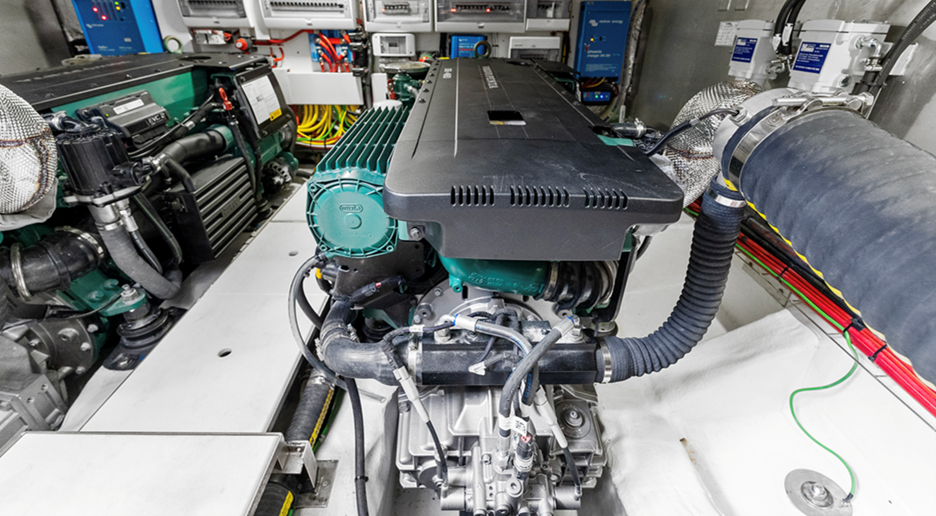
All critical engine fluid locations are situated on the inboard sides of the twin 480-hp Volvo Penta D6 diesels. Wiring, battery chargers, and other equipment are all positioned on bulkheads. The propulsion system is a V-Drive for more room forward in the accommodations section.
It should be noted that both heads have gray water sumps with automatic overboard discharge pumps. There is one stainless steel black water holding tank with an odor filter. Its electric discharge pump is located in the engine room and the system is designed for dockside pump out, however, there is a standard Y-valve for discharge beyond the 3-mile limit. The USCG requires that the be a breakable seal on the Y-valve arrangement to prevent accidental (Ahem) discharge.
Factory Options
- Gloss walnut or eucalyptus cabinetry
- Bow and/or stern thruster
- Foldable soft bimini top
- Cablemaster
- Raymarine electronics package
- Swim platform wet bar/grill
- Seakeeper 5 gyro
- Hydraulic swim platform
- Underwater lights
Observations
Galeon used the world-class nautical design firm of Tony Castro Yacht Design for interior layout and décor. We think Castro and the company did an excellent job of maximizing functionality in the space provided for it.
The Galeon has packed a lot of functionality and utility into the 440 Fly and 450 HTC. It takes the place once filled by American brands that long ago went out of business and served this middle market of cruisers. We think both models are good transition vessels for owners moving up from smaller vessels. With them, people can get a taste of the cruising lifestyle with a boat that has a lot to offer, and is not too expensive. In fact, that we think many people “transitioning” may decide this boat is all they ever need.

